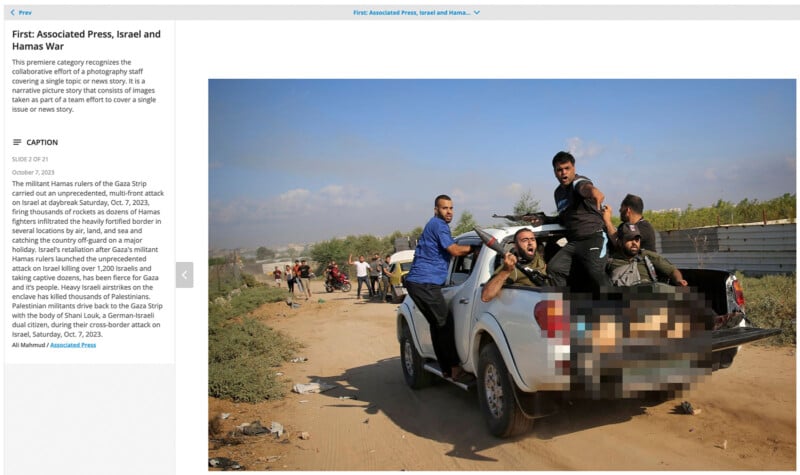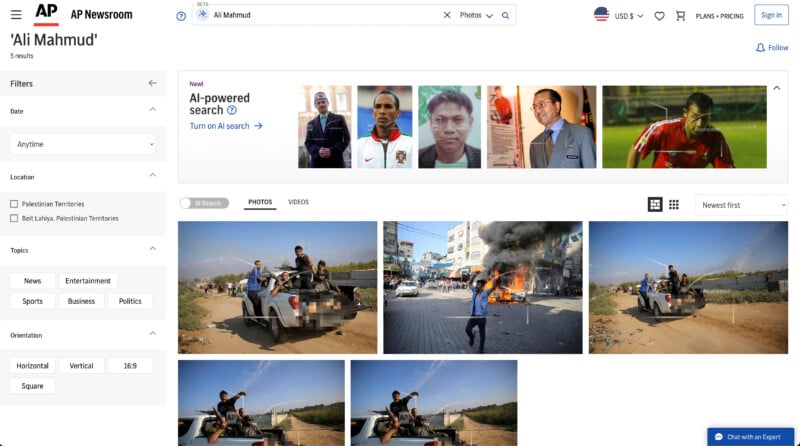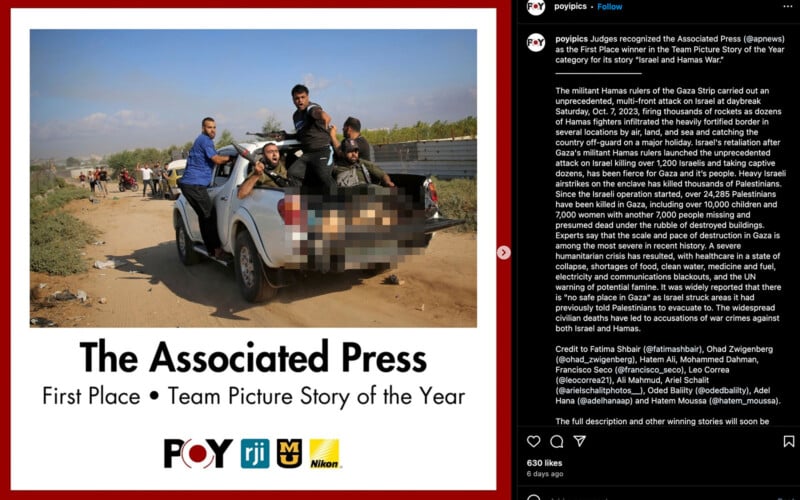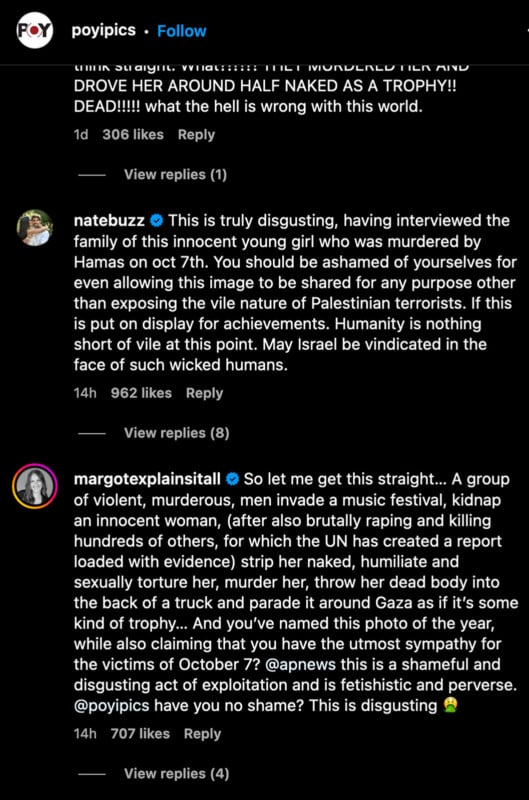Pictures of the Year Sparks Controversy, Awards ‘Disgusting’ War Photo Top Prize
![]()
The longest-running photojournalism competition, Pictures of the Year, recently announced the winners of its 81st contest. While most have been celebrated, the top prize in the “Team Picture Story of the Year” category has been highly controversial, kick-starting a powerful, emotional debate about the nature of photojournalism itself.
Warning: This story concerns a photo that some readers may find disturbing. PetaPixel will not publish uncensored versions of the image. However, outbound links in this article will lead to the uncensored version of the image.
Associated Press Photographers Win Award for Controversial War Photos
The Associated Press has won this year’s Team Picture Story of the Year Award thanks to contributions from photojournalists Fatima Shbair, Ohad Zwigenberg, Hatem Ali, Mohammed Dahman, Francisco Seco, Leo Correa, Ariel Schalit, Oded Balilty, Adel Hana, Hatem Moussa, and Ali Mahmud. The specific image that is at the core of the most outrage, which is also the one that Pictures of the Year opted to share first on Instagram and feature on its website, was captured by freelancer Ali Mahmud.

Allegations Against Photojournalists in Israel and Gaza
Mahmud is one of the journalists who have come under scrutiny for their potential involvement or knowledge of Hamas’ October 7th attack, when many Israeli civilians were abducted and killed.
The Pro-Israeli advocacy group Honest Reporting alleged that some journalists on the ground in Gaza were associated to Hamas. In response, CNN severed its ties with a photographer with alleged links to Hamas. In contrast, other outlets, including Reuters, AP, and New York Times, cited that they all use freelance journalists around the world, including in Gaza, but denied any advance knowledge of the October 7th attacks.
Honest Reporting also posted about the specific Pictures of the Year award.
“Congratulations to @AP for winning a Pictures of the Year award. How does it feel to do so on the back of Palestinian photojournalists who infiltrated Israel on Oct. 7 and took photos like the one below of Shani Louk’s dead body in a Hamas pickup?
“Was @RJI bothered about that before bestowing the award?”
Honest Reporting has also written an article on the award, claiming that “bestowing such honors carries far-reaching ramifications. The photographers and their organizations gain reputational, professional and financial benefits from such recognition.” Honest Reporting maintains that there are concerns about the winning photographers despite having backtracked on some of its initial allegations.
The Associated Press still has Mahmud’s images in its database as of now.

The National Jewish Advocacy Center (NJAC) sued the Associated Press in February regarding the AP’s coverage of the October 7th attacks in Israel, alleging that the AP provided “material support for terrorism” by buying photos from Hamas-affiliated photographers.
The AP’s statement on the lawsuit vehemently denies the allegations, affirming that AP had no advance knowledge of the attacks, had no evidence at any point, including now, that freelance contributors have Hamas affiliation, and that any allegations to the contrary are reckless and dangerous.
“Documenting breaking news events around the world — no matter how horrific — is our job. Without AP and other news organizations, the world would not have known what was happening on Oct. 7,” the Associated Press says, establishing its continued commitment to documenting the world’s events, no matter how disturbing or awful they may be.
The Associated Press’ annual photo feature, “The year in photos: AP’s most memorable photos of 2023“, included Mahmud’s image plus numerous others showing dead bodies.
PetaPixel contacted the Associated Press before publishing this story but received no callback or email response.
Unfortunately, the most important news worldwide often includes stories of pain, suffering, and death. For example, The Associated Press also recently won a prestigious duPont Columbia Award in broadcast journalism for its documentary 20 Days in Mariupol, a moving, albeit disturbing, documentary about the war in Ukraine produced in partnership with PBS. The documentary, which includes imagery of dead children, did not garner anywhere near the same outrage as the image of Shani Louk.
What People Are Saying About the Award-Winning Photograph of a Deceased Shani Louk
While some of the criticism about the prize-winning photos in Gaza concerns the integrity of the photographers who captured them, the strongest outrage is focused primarily on the content of Mahmud’s featured picture, which depicts the half-naked corpse of 23-year-old German-Israeli artist Shani Louk in the back of a pickup truck as Hamas militants drove Louk’s body on October 7, 2023, the day of the cross-border attack.

The Israeli Ministry of Foreign Affairs officially confirmed Louk’s death in late October, posting on X: “We are devastated to share that the body of 23 year old German-Israeli Shani (Louk) was found and identified.”
“She was a beautiful, lively person,” Shani’s mother Ricarda Louk told CNN in October, one day after Louk’s death was confirmed. “She just enjoyed laughing, and experiencing life, and so it was just cut too short.”
Louk was reportedly kidnapped from the Nova music festival. Israel’s foreign ministry says that Louk was “tortured” and “paraded around Gaza by Hamas terrorists.”
While the image of Louk was quickly circulated online in the wake of the attack on October 7th, some falsely believed that she was alive but unconscious in the image. Israeli officials say that based on additional evidence, the now award-winning photo was taken after she had already been killed by gunshot, according to The New York Times.
What is driving much of the disgust online about the image is although Louk’s face is not visible, people know who it is and despise that a young woman’s death is being featured through published imagery.
“NO ONE should win an award for taking a picture of her horrific death… least of all someone who was able to be that close to the massacre…. This is the most disgusting coverage I’ve ever seen,” writes Elisheva Needelman-Ruiz in the top comment on Instagram, which has received nearly 2,000 likes in less than 24 hours — far outpacing the 630 likes on the post itself from last week.
“There is a dead body of a partially unclothed human being, a young woman who was brutally murdered and probably raped. This cannot be real. Please remove this photo,” adds a private account called “myroyalaccount.”
“Picture of the year?? Seriously?? Have you seen the videos of this scene? They drag Shani Louk’s body in their car, almost completely naked, and spit on her and scream Alahu Akbar, seriously, THIS IS YOUR PHOTO OF THE YEAR?????” asks an outraged מרים Miriam, an Israeli photography student.
“This is truly disgusting, having interviewed the family of this innocent young girl who was murdered by Hamas on Oct 7th. You should be ashamed of yourselves for even allowing this image to be shared for any purpose other than exposing the vile nature of Palestinian terrorists. If this is put on display for achievements. Humanity is nothing short of vile at this point. May Israel be vindicated in the face of such wicked humans,” writes another user, Nathaniel Buzolic.
Others note that Louk’s family “specifically requested” that Shani Louk be remembered as happy and believe that showing a photo of her corpse is disrespectful and should not be tolerated.
Another Instagram user, Cayla Duchene, writes, “May every one of those ‘award-winning photographers’ have a similar ride on such a truck.”
Duchene’s comment leads to another common sentiment among commentators who believe that the photographer, Mahmud, should have “done something” other than taking a picture, implying that there was the possibility of stopping Hamas militants at that moment.
There have also been numerous attacks on the Pictures of the Year competition organizers, and people have questioned their purported lack of “humanity” and “decency.”

Nouk’s Father Does Not Share These Sentiments
One person who is not bothered by the winning photo is Shani Louk’s father, Nissim. He told Ynet News that it’s good that the image of his deceased daughter won the prize because it is “one of the most important photos in the last 50 years.”
“These are some of the photos that shape human memory, the Jew raising his hands, the paratroopers at the Western Wall, photos that symbolize an era. This documentation of Shani, and of Noa Argamani on the motorcycle, they symbolize this era. I think it’s a good thing to use it to inform the future. If I start crying, what will come of it? This is history. In 100 years they will look and know what happened here. I travel the world and everyone knows who Shani is,” Nissim says.
The Pictures of the Year Competition and Its Sponsors Value Photojournalism
Pictures of the Year International was started in 1944 by Cliff Edom at the Missouri School of Journalism in Columbia, Missouri. It celebrates its 75th anniversary this year, and is currently run by the Donald W. Reynolds Journalism Institute at the Missouri School of Journalism and sponsored by Nikon.
Images that win awards in the Pictures of the Year competition had to be entered by the photographers themselves or the news organization that employs them or publishes their work. This means that the Associated Press entered Mahmud’s image and the other award-winning photos.
Nikon, which sponsors the Pictures of the Year competition by its commitment to the Donald W. Reynolds Journalism Institute, tells PetaPixel the following via email:
At Nikon, we are committed to supporting photojournalism. As part of this commitment, Nikon is a sponsor of the Pictures of the Year International, and the images are selected and judged by a panel of professional journalists.
As for the Pictures of the Year competition itself, the contest organizer, Lynden Steele, provided the following statement to PetaPixel:
The Reynolds Journalism Institute and Pictures of the Year strongly condemn the Hamas attack on Oct. 7, and we continue to mourn the loss of innocent lives and human suffering that is occurring in the ongoing conflict. Reactions to the Team Picture Story of the Year express the greater emotions related to that conflict. This year and every year, the photos in the competition are selected by a panel of professional journalists tasked with identifying compelling representations of the significant news events of the year. While we understand the reactions to the pictures, we also believe that photojournalism plays an important role in bringing attention to the harsh realities of war.
Sometime either late last night, March 28, or today, March 29, Pictures of the Year’s Instagram post about the Team Picture Story of the Year winners, including Mahmud’s photo, was removed. PetaPixel asked Pictures of the Year if it had removed the photo, and the organization says it did not. The image must have been removed by Instagram.
Are People’s Views Toward Photojournalism Changing?
The controversy raises a lot of questions for people about the nature of photojournalism, a photographer’s obligations to people, especially those who have been killed, and what sort of images should even be captured, published, or awarded.
The ongoing concerns with some of the specific journalists in Gaza and their alleged ties to Hamas are relevant to this situation, but some of the other questions concern journalism at large.
When is the photographer themselves part of the story? What is too graphic to photograph? Does publishing a photo imply a political position?
And, perhaps most importantly, how should news organizations and the journalists they employ grapple with the fact that what is news to some feels very different to those who are personally affected by the depicted events?
War is certainly not new, and photographs from war aren’t new either. However, people’s beliefs about the value of these images may be shifting.